|
Quintessentially Cantonese
By Stanson Zhou (that's Guangzhou)
Updated: 2004-05-14 10:37
If cooking is a Cantonese religion, then the chefs are its high priests and priestesses. Cantonese dishes have made a name for themselves in every corner of the globe.that's Guangzhouinterviews four masters who represent this culinary tradition. Find out how these wizards of the wok work wonders in the kitchen and why some dishes are considered quintessentially Cantonese.
Liu Che Lik
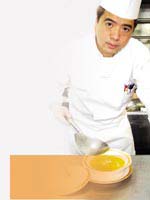 From childhood, Liu Che Lik has always loved cooking. Hanging out with his uncle in Hong Kong, who happened to be head chef of the city's famed Ya Yuan Seafood Restaurant, started Liu on his own path to chefhood . As a 14-year-old, Liu swept restaurant floors by day, while at night he sharpened his culinary skills by practising at home what he had learnt peering over the shoulders of some of the city's greatest chefs. From childhood, Liu Che Lik has always loved cooking. Hanging out with his uncle in Hong Kong, who happened to be head chef of the city's famed Ya Yuan Seafood Restaurant, started Liu on his own path to chefhood . As a 14-year-old, Liu swept restaurant floors by day, while at night he sharpened his culinary skills by practising at home what he had learnt peering over the shoulders of some of the city's greatest chefs.
"When I was working in the kitchen I would ask as many questions as I could of the other chefs," said Liu. Liu is currently executive chef of Chinese cuisine at the China Hotel.
After spending seven years in Guangzhou, Liu has earned a reputation as one of the city's top chefs and knows where to find good Canto-grub. "I like to go out when I have free time and try different dishes so I can get more ideas for my own cooking," said Liu, whose favourite restaurants include the Dong Hai Seafood near City Plaza in Tianhe and the Lijing Ming Zhu near the Pearl River New Estates.
According to Liu, the glory of Cantonese cooking is in its constant state of change and ready incorporation of other cuisines. One such example ishuang shao chi, also known as imperial braised shark's fin (RMB 268). While Liu is tight-lipped about the details of his recipe, he confesses the light soup uses duck, chicken and ham in the soup stock. Specially imported fish from southern Australia is used as the main ingredient.
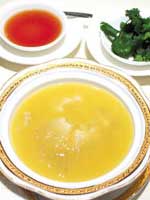 Liu'shuang shao chiis a variation of shark fin's soup invented by Tan Zongjun, a Guangdong-born Qing Dynasty official who is famed for creating a series of dishes which includes bird's nest soup. These and about 200 other recipes are now known as Tan Family Cuisine. Liu'shuang shao chiis a variation of shark fin's soup invented by Tan Zongjun, a Guangdong-born Qing Dynasty official who is famed for creating a series of dishes which includes bird's nest soup. These and about 200 other recipes are now known as Tan Family Cuisine.
We cannot promise you five-star results like Liu's, but see the sidebar for a basic idea of how to whip up some of your own shark's fin.
Braised Shark's Fin
Ingredients:
1700g shark's fin soaked in water
25g dried scallops
250g minced ham
3000g chicken fat
750g duck meat
Method:
1. Steam the shark's fin and then boil with seasonings until the fishy smell is gone, remove to a bowl.
2. Put the chicken and duck in boiling water, boil till soft and tender.
3. Place the chicken, duck and ham on the shark's fin, simmer for six hours.
4. Put the shark's fin into a saucepan. Steam the dried scallop till tender, pour together with the soup over the shark's fin, boil, transfer to a plate and sprinkle with minced ham.
Chen Shu Xin
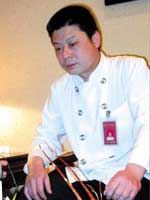 Chen Shu Xin had humble beginnings, cleaning fish at the Dong Fang Hotel just as China was opening up in the early '80s. For ten years he worked his way up the culinary ladder and helped feed such eminent guests as Queen Elizabeth II and Margaret Thatcher. Now Chen heads the kitchen staff at Xin Li Zhi Wan Jiu Lou in the Electronic Plaza on Huanshi Dong Lu. Chen Shu Xin had humble beginnings, cleaning fish at the Dong Fang Hotel just as China was opening up in the early '80s. For ten years he worked his way up the culinary ladder and helped feed such eminent guests as Queen Elizabeth II and Margaret Thatcher. Now Chen heads the kitchen staff at Xin Li Zhi Wan Jiu Lou in the Electronic Plaza on Huanshi Dong Lu.
Despite Chinese food's international renown, local chefs in Guangzhou feel they don't receive enough recognition for their gourmet creations. "Chinese chefs still don't have as much exposure as French chefs do because this industry is just starting to open up," says Chen. "We're just starting to have more opportunities for international exposure and exchange."
One factor helping Cantonese chefs into the international limelight is the recent fusion trend known as 'New Style Cantonese,' which adds Western ingredients to Cantonese dishes. Ingredients such as parsley, cheese and olive oil are now used in Cantonese cooking. "This adds a lot more flavour and variety to Cantonese cuisine," explains Chen.
Current affairs create trends and seasons too. This year's theme is health food, courtesy of avian flu and SARS. More veggies are on the menu this year, explains Chen, along with organic ingredients fresh from the countryside.
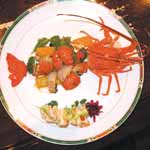 An excellent example of New Style Cantonese cooking recommended by Chen is a braised lobster dish calledxi jiao chao longxia(RMB 188). A trio of onion and green and yellow pepper slices are lightly fried and pasted with a soy andhuangdousauce which is spread over succulent steamed lobster chunks, which fall right off the shell into your mouth. An excellent example of New Style Cantonese cooking recommended by Chen is a braised lobster dish calledxi jiao chao longxia(RMB 188). A trio of onion and green and yellow pepper slices are lightly fried and pasted with a soy andhuangdousauce which is spread over succulent steamed lobster chunks, which fall right off the shell into your mouth.
Chen also whips up an artfully prepared Chaozhou dish calledhua kai fu gui(RMB 88). This consists of dumplings made of a savoury mash of crab meat, crab's eggs and squid delicately wrapped in tofu skins and deep fried. Half a dozen crisp and leafy dumplings are ingeniously displayed to appear as a flower emerging from a cluster of rocks, all done with a little help from some mushrooms and a spring onion.
Gao Xu Lian
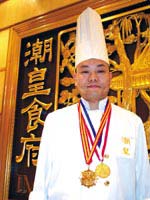 Ask any connoisseur of Chinese food what style of cooking is best associated with a light (qingdan) taste and their answer will probably be Chaozhou food. Best known for its seafood delicacies, Chaozhou cuisine has long been connected to Cantonese food, largely because of the coastal city's proximity to Guangzhou. Few people know Chaozhou cuisine better than Imperial Palace executive chef Gao Xu Lian, who not only creates new dishes but also manages the staff and is involved on the restaurant's business side. Ask any connoisseur of Chinese food what style of cooking is best associated with a light (qingdan) taste and their answer will probably be Chaozhou food. Best known for its seafood delicacies, Chaozhou cuisine has long been connected to Cantonese food, largely because of the coastal city's proximity to Guangzhou. Few people know Chaozhou cuisine better than Imperial Palace executive chef Gao Xu Lian, who not only creates new dishes but also manages the staff and is involved on the restaurant's business side.
"Nowadays a good chef can't just be a good cook, he has to do a lot of things," says Gao, who has won a slew of cooking and restaurant awards including the Chinese Cooking Master title from the China Restaurant Association. Like many chefs of his generation, Gao started cooking in his teens and was influenced by family in the restaurant trade. While Gao first oiled his wok in his home town of Shantou, he also worked his way around the country from Beijing, Shanghai and Chengdu to Anhui Province.
Gao's clients include some of the city's most successful and discerning businessmen. Some of the country's top leaders such as Jiang Zemin and Hu Jintao have also sampled his work.
According to Gao, clients are demanding healthier food that not only scores high on taste but also on presentation. Dishes prepared with red wine and green tea are now appearing on the menu at Imperial Palace and Gao incorporates a Japanese-style approach in arranging these dishes.
"Now more people want smaller portions of food, but that which is also healthy and delicious," says Gao, who adds that customers also expect more personal service when dining out. "My customers want to be guided on what kinds of food are best suitable for them without paying too much money."
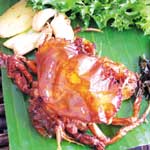 A classic example of this can be seen and tasted in his soft-shell crab creationqing ke xie(RMB 48), which includes a savoury ensemble of ginger, garlic, green tea and Coca Cola cooked in a light oil (tiao he you). "In Guangzhou many people drink Coca Cola and ginger to fight off a cold, so this dish has some health benefits," says Gao. A classic example of this can be seen and tasted in his soft-shell crab creationqing ke xie(RMB 48), which includes a savoury ensemble of ginger, garlic, green tea and Coca Cola cooked in a light oil (tiao he you). "In Guangzhou many people drink Coca Cola and ginger to fight off a cold, so this dish has some health benefits," says Gao.
Soft Shell Crab
Ingredients:
1 soft shelled crab
green tea leaves (biluochun)
50g Coca Cola
10g sliced ginger
olive or peanut oil
Method:
1. Simmer crab in boiling oil for a few minutes then remove and set aside.
2. Steep tea leaves and separate base.
3. Combine tea base with ginger slices and Coca Cola, heat together for a few minutes.
4. Simmer crab in tea, cola and ginger base until cooked.
Guan Wei Qiang
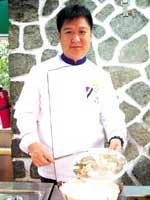 Porridge has its many manifestations around the world, from oatmeal to grits to cream of wheat, but perhaps the gruel with the longest history hails from Guangzhou, known locally asjok, orzhoufor Mandarin speakers. Porridge has its many manifestations around the world, from oatmeal to grits to cream of wheat, but perhaps the gruel with the longest history hails from Guangzhou, known locally asjok, orzhoufor Mandarin speakers.
Guangzhou native Guan Wei Qiang, masterzhoumaker and head manager at Zhou Cheng in Liu Hua Park, has developed porridge into an art form and built a mini empire based on this authentic Cantonese dish.
"Zhouis considered one of the most basic kinds of Cantonese food. You can't get more local than that," says Guan, who has been makingzhouall over China for the past 20 years.
When he was 15, Guan started cooking at a local dim sum restaurant and later graduated to five-star status when he worked at the Garden Hotel in 1984. By the early '90s, Guan had worked in cities outside Guangdong including Lanzhou and Dalian. In 1996 he opened Zhou Cheng, which branched out into nine outlets across the city.
According to Guan, there are two kinds ofzhou. The first kind, known aslao huo zhou, cooks ingredients together with water and rice over a long period. The second,sheng huo zhou, cooks the rice and water together for a long time, adding other ingredients at the end. The second kind includes local favourites such as pork liver zhou (zhu gan zhou) and 1,000 year egg zhou (pidan zhou).
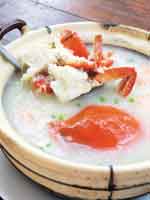 The beauty ofzhouis that it can be eaten at any time of the day and that there is no limit to the kinds of ingredients you can add. A good illustration of this isting zai zhou, which came to popularity in the Qing Dynasty and hails from Liwan District, where fishermen used to sell whatever they caught. According to Guan, one enterprising fishmonger whipped up a tasty mixture of fresh fish chunks, shrimp, seaweed, jellyfish and pork and then sold it to businessmen visiting the area's red light district. The beauty ofzhouis that it can be eaten at any time of the day and that there is no limit to the kinds of ingredients you can add. A good illustration of this isting zai zhou, which came to popularity in the Qing Dynasty and hails from Liwan District, where fishermen used to sell whatever they caught. According to Guan, one enterprising fishmonger whipped up a tasty mixture of fresh fish chunks, shrimp, seaweed, jellyfish and pork and then sold it to businessmen visiting the area's red light district.
While Guan has a taste for all things traditional, he also sees himself as an innovator. "I have two personalities," said Guan. "One likes really old things, another likes really new things."
Guan has successfully incorporated this innovative side into his business by taking something as traditional aszhouand turning it into a very personalised cuisine. Zhou Cheng's signature style is a kind of DIY porridge. Patrons can choose from a variety of ingredients to create their own zhou.
"You can use a lot of things to makezhou," says Guan. "My only requirement is that the taste must be a bit sweet, fragrant and smooth."
|
